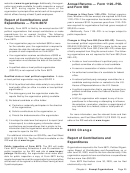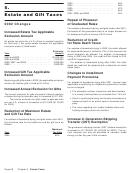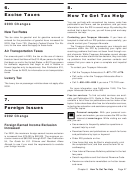Publication 553 - Highlights Of 2002 Tax Changes Page 11
ADVERTISEMENT
Dollar limit. The limit on the amount of qualifying ex-
Disclosure of Reportable
penses will increase to $3,000 for one qualifying individual
Transactions
and to $6,000 for two or more qualifying individuals. For
2002, the amounts were $2,400 and $4,800 respectively.
For each reportable transaction that you enter into after
2002 and in which you participated directly or indirectly,
Earned income amount for student-spouse or spouse
you must attach Form 8886, Reportable Transaction Dis-
not able to care for self. The amount of earned income
closure Statement, to your return for each year that your
your spouse, who is either a full-time student or not able to
tax liability is affected by your participation in the transac-
care for himself or herself, is treated as having earned is
tion. In addition, for the first year you disclose a reportable
increased to $250 a month if there is one qualifying person
transaction, you must send a copy to:
and to $500 a month if there are two or more qualifying
persons. For 2002, the amounts were $200 and $400
Internal Revenue Service
respectively.
LM:PFTG:OTSA
Large & Mid-Size Business Division
Tax Benefits for Adoption
1111 Constitution Avenue, NW
Washington, DC 20224.
Increased
Beginning in 2003, the maximum adoption credit or exclu-
Reportable transaction. A reportable transaction is a
sion increases to $10,160. In the case of the adoption of a
transaction or series of transactions described in one or
child with special needs, this amount will be allowed re-
more of the following six categories.
gardless of whether you have qualifying expenses. See
1) Listed transactions. This category includes trans-
Publication 968, Tax Benefits for Adoption, for more infor-
actions that are the same as or substantially similar
mation.
to one of the types of transactions that the IRS has
determined to be a tax avoidance transaction. These
Estimated Tax Requirements
transactions are identified by notice, regulation, or
for Higher Income Taxpayers
other form of published guidance as a listed transac-
tion. For existing guidance, see the instructions for
For installment payments for tax years beginning in 2003,
Form 8886. There may be subsequent guidance
the estimated tax safe harbor for higher income individuals
identifying additional listed transactions.
(other than farmers and fishermen) has been modified. If
2) Confidential transactions. This category includes
your adjusted gross income is more than $150,000
transactions that are offered under conditions of con-
($75,000 if married filing a separate return), you will have
fidentiality. See section 1.6011-4T(b)(3) of the regu-
to pay the smaller of 90% of your expected tax for 2003 or
lations for more information.
110% of the tax shown on your 2002 return to avoid an
estimated tax penalty. See Publication 505, Tax Withhold-
3) Transactions with contractual protection. This
ing and Estimated Tax, for more information.
category includes transactions for which you have or
expect to have contractual protection against the
Health Insurance Credit
possibility that part or all of the intended tax benefits
from the transaction will not be sustained.
At a date to be announced in 2003, an older worker eligible
4) Loss transactions. For individuals, this category in-
for the alternative trade adjustment assistance program
cludes transactions that result in, or are likely to
can qualify for the health insurance credit if he or she:
result in, a gross loss (before netting any gain
against it) of at least $2 million in any single tax year
1) Is covered by a qualifying certification,
or $4 million in any combination of tax years. The
2) Is reemployed not more than 26 weeks after the date
loss amount is at least $50,000 for a single tax year
of separation from the adversely-affected employ-
if the loss involves a foreign currency transaction
ment,
defined in section 988(c)(1) of the Internal Revenue
Code. Different limits apply to corporations, partner-
3) Is at least 50 years of age,
ships, and S corporations.
4) Does not earn more than $50,000 a year in wages
5) Transactions with significant book-tax differ-
from reemployment,
ences. This category includes transactions in which
5) Is employed on a full-time basis, and
the treatment for federal income tax purposes of any
income, deduction, or credit item or items from the
6) Does not return to the employment from which he or
transaction differs, or is reasonably expected to dif-
she was separated.
fer, by more than $10 million on a gross basis from
More information will be available when the program be-
the treatment of these items for book purposes in
gins.
any tax year. This category applies only to:
Chapter 1 Tax Changes for Individuals
Page 11
ADVERTISEMENT
0 votes
Related Articles
Related forms
Related Categories
Parent category: Financial
 1
1 2
2 3
3 4
4 5
5 6
6 7
7 8
8 9
9 10
10 11
11 12
12 13
13 14
14 15
15 16
16 17
17 18
18 19
19 20
20 21
21 22
22 23
23 24
24 25
25 26
26 27
27 28
28 29
29 30
30 31
31








